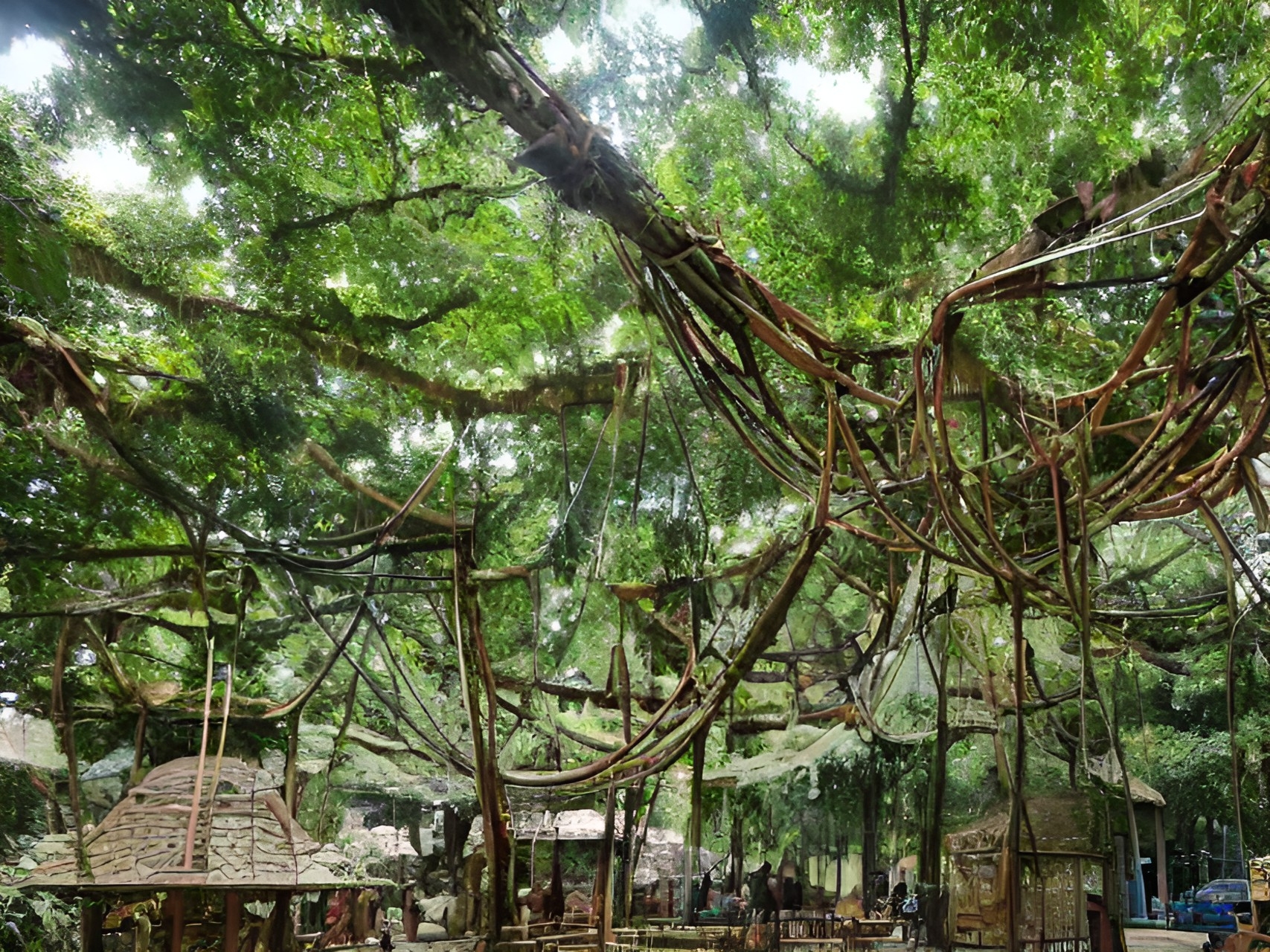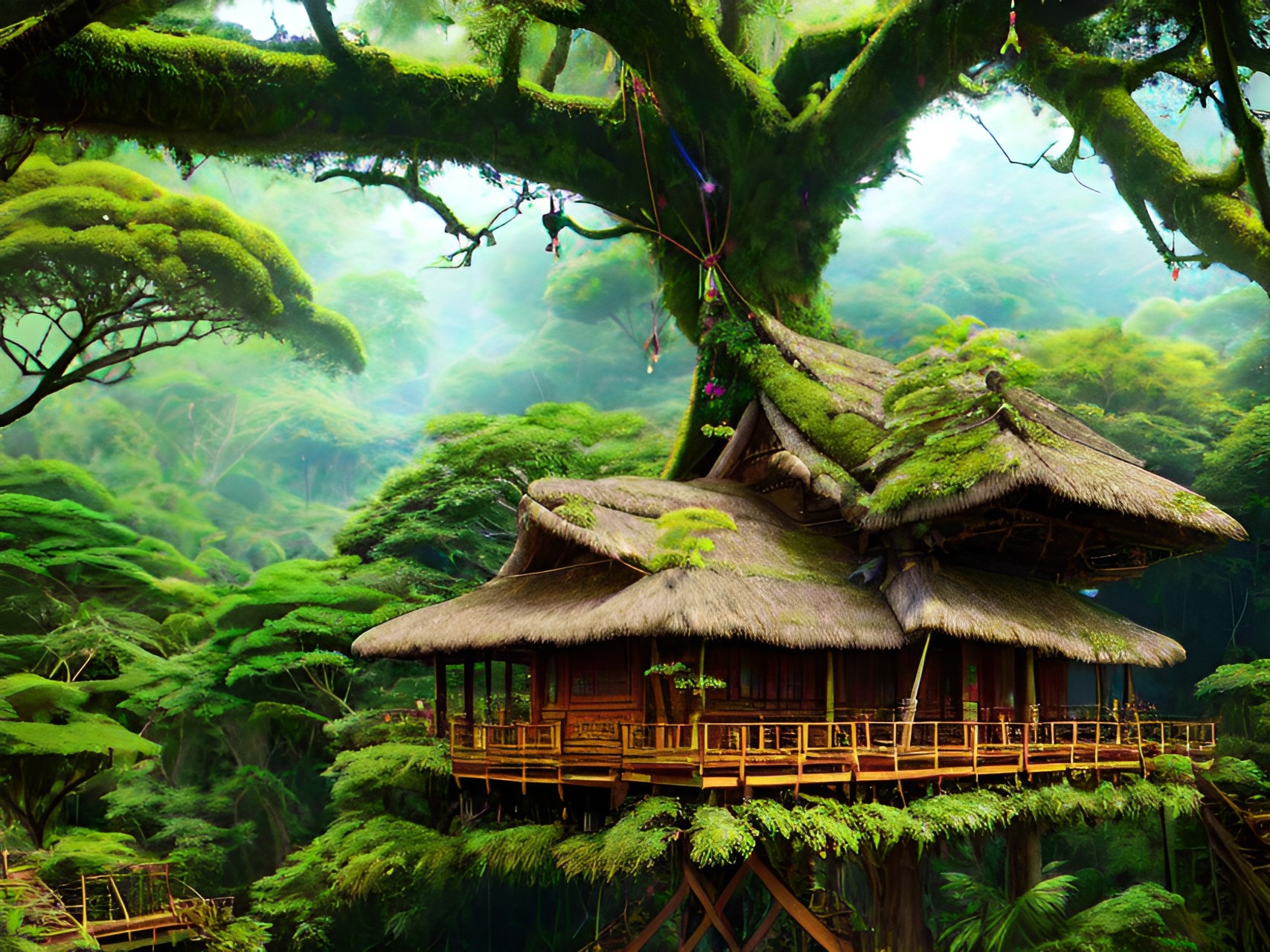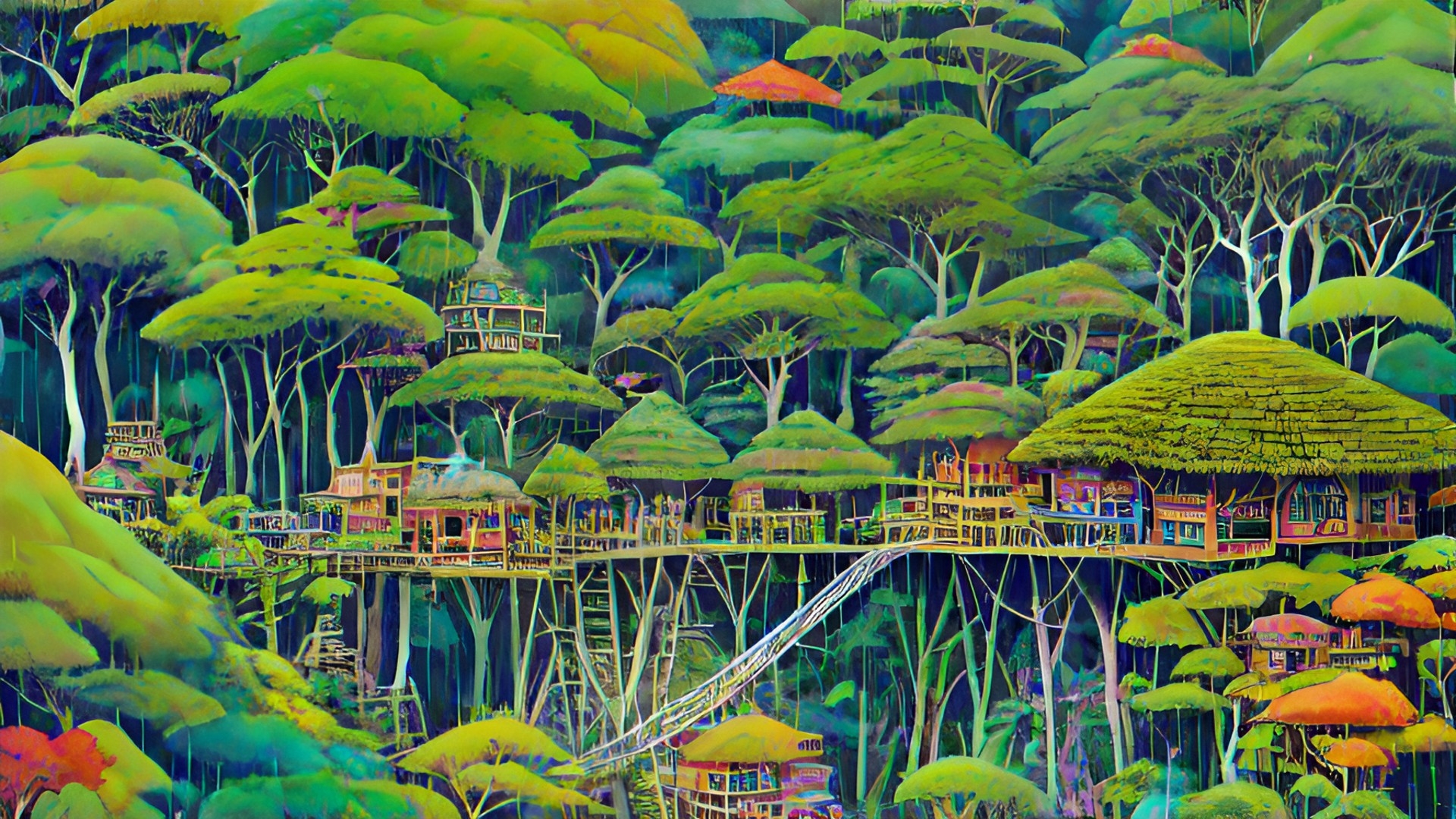Pakaysacha (Pah-kuh-eye-sah-chah)
Within the lush and diverse rainforest of the Isthmus of the Huntsman, a city stretches across the branches of the canopy. The forest floor is rife with dangerous predators and, in recent years, Accian soldiers. Utilizing their Racial Magic and working alongside nature, the Bakongo of the Isthmus and their Tawantinsuyu benefactors constructed their city into the branches of the forest, the resulting city carrying the fingerprint of both cultures.
Wood platforms and rope bridges link together and blend seamlessly into the treetops, not harming their verdant hosts. Raw stones are plastered together with thatch or leafy rooves for many of their buildings, painted in a vibrant variety of colors. Other buildings and even bridges consist instead of living branches carefully guided into place as they grew or reshaped by magic. There are still a number of nomadic tribes and smaller settlements throughout the rainforest but this is their largest city and the base of Supay the Huntsman and his Chakuqpa Runan allies.
Most of the Tawantinsuyu society is based further south in the Continent Beyond as the Kingdom of Accia calls it but as far as the kingdom is aware, this enemy settlement is at the edge of their known world. The same can be said of the Tawantinsuyu Empire, Pakaysacha located at the frontier of their lands. Accia has yet to locate this mysterious village, unaware of its atypical construction, and Chakuq Supay is cautious in maintaining its concealment. Their settlement has also seen considerable expansion since the kingdom set their eyes on the region, many nomadic tribes or smaller villages fleeing to this city to evade conflict or even as refugees. Supay, his chakuqpa runankuna and the Tawantinsuyu Empire are fiercely protective of this last stronghold, determined to halt Accia's advance south into lands yet unknown to their northern neighbors.
Demographics
Those residing here are a mix of Tawantinsuyu migrants, merchants or soldiers and local Bakongo. Many of these locals fled south as the kingdom claimed their homes. Citizens are generally untrusting of any outside races, especially northern Eluzians. Until Accia's expansion, they were relatively insulated from their northern neighbors only interacting with those living in the Festering Peninsula or the pirates based there.
Most living within the city possess Racial Magic associated with Fliral, Lunil and even Banalkar. It was by utilizing these abilities that they were able to construct their city so seamlessly with the forest and how they are able to continue to safely reside here. Most if not all of the chakuqpa runankuna possess Banalkar's blessings for which they are named. Their leader is suspected by the kingdom to be a Divine Descendant of Banalkar.
Government
Since Supay took up his role as defender of this region, none have contested his leadership. He found he was unexpectedly suited to city planning. He has those he trusts amid his men but otherwise, all decisions and leadership defaults to this mysterious but fearsome warrior. However, they do have an appointed governor who handles the menial day to day tasks and organizes public events when Supay is busy fighting the kingdom. The chakuqpa runankuna and those amid the village clearly revere their Chakuq but his true identity remains a mystery to the outside world.
Defences
Their greatest defence is the secrecy of their location and their position above the forest floor. Every structure and plaza is carefully screened with canopy branches or vines and all rooves are similarly green, camouflaging the city from above. Only a handful of hidden ladders lead up into the city. Furthering this, a number of concealed platforms are placed around the perimeter of the city, chakuqpa runankuna stationed at these in shifts.
Each individual chakuqpa runan possess a whistle which is inaudible to human ears but easily picked up by other chakuqpa runan inside the city, blessed by Banalkar. The chakuqpa runankuna possess various bestial features, many of which include superior animal hearing. If a whistle sounds, rather than engaging with an invader they will activate a protective enchantment designed to mask the presence of the city from those below (sights, sounds, smells, etc.) Accian patrols have wandered underneath the city multiple times, totally unaware. If this is to fail and the city falls under attack, citizens retreat to the fortified garrison while Supay and his men fend them off.
Industry & Trade
As the city has expanded, taking in more refugees, they have come to lean on the aid of the Tawantinsuyu Empire as a benefactor and trade partner. Despite this heavily weighing in the city's favor, this is because the empire views them as an investment in their own security. They regularly send both supplies and more men.
Infrastructure
As they are built into the branches of the canopy, they needed to be extremely resourceful and crafty with their infrastructure. An example of this is their source of clean water. A system of troughs lays above the trees akin to aqueducts, carefully camouflaged into the branches, which catches fresh rainwater before running down into various reservoirs throughout the city all citizens have access to. Excess simply runs down into the forest below and the constant movement of this water assures it's freshness.
History
This city was not originally built or occupied by the Tawantinsuyu. This was actually a very recent occurrence. Pakaysacha was once a small, peaceful unnamed village constructed by local Bakongo as an adaption for evading predators below. However, as Accia continued it's conquest south and refugees continued pouring into the Tawantinsuyu Empire, they became wary of this expansion. Supay the Huntsman appeared amid this uncertainty from among their own people and had his chakuqpa runankuna ready to follow him into battle. They swept into the region, resisting the kingdom at every turn and successfully curbing their advance.
As it became obvious this conflict was far from its end, he and his men settled onto this once small village as their base. They began acting as Pakaysacha's guardians in exchange for safe haven. They also expanded the village under his guidance, receiving resources and men from the Tawantinsuyu Empire which became invested in their activities. They view Supay and his warriors as their best barrier against the kingdom.
Many locals also fled to the burgeoning city, seeking their own sanctuary from the Accian invaders. What started as an unsteady and uncertain blending of these two cultures gradually fell into steadfast cooperation as they fought, built and thrived together, unified in purpose and enemy. Supay himself saw to the balance between these residents, hosting and overseeing cultural events himself. It is under these circumstances that Pakaysacha, the village of "hidden tree", "secret sight", "secret forest" or simply "the secret", morphed into the thriving city and Den of the Huntsman.
Architecture
Most of the Tawantinsuyu empire lays further south, totally unknown to the Kingdom of Accia. Intricate and impressive stone architecture with geometric patterns, clusters of kancha and high walls are the mainstay of their typical architecture. However, the isthmus is as much of a frontier to the Tawantinsu as it is to the Accians. They have had to drastically adapt their usual designs for this their furthest outlying city, draped in thick rainforest rather than jagged mountainsides.
This city was reconstructed alongside the efforts of local Bakongo. A mixture of stone and mud mortar or simple wooden structures are capped by thatch or leafy rooves alongside the manipulation of the living branches themselves. Similar to the Tawantinsuyu's "kancha", most of these rectangular buildings are clustered together into groups of three or so, centered on platforms surrounding or nestled into an individual tree. Their leafy rooves blend in perfectly with the leaves of the canopy, camouflaging the village from the vision of aerial scouts. Bridges of rope and wood link the patios of these clusters together, some bridges crafted by guiding the growth of branches into the desired shape either naturally or by using Torrym magic.
Larger buildings imitate the Tawantinsuyu's "kalanka", typically having several doors and facing a large open space, trapezoid in shape. These are used for public spaces and gatherings. Another structure from this culture is the "ushnu", a viewing platform from which the Huntsman can observe important ceremonies and judicial proceedings. This is located on one side of their main plaza, attached to his home. The main plaza is the largest in the city, located centrally and appears to hover over the forest below suspended by thick, living vines and branches. Their primary market lines this plaza while their Chakuq's personal home overlooks the entire structure.
Most of their buildings are rectangular with one entrance composed of a single room. Open buildings with no closed walls are also common, appearing as geometric awnings. Some structures, depending on purpose, might be long with multiple doors or even circular or u-shaped variations. Most buildings are single story, evading weighty structures, but as the village continues to expand they have begun constructing multiple vertical layers in a spiral pattern ascending or descending the trunk. Exterior walls slope inward as they rise, giving buildings a trapezoid form to make the walls seem higher and thicker than they are. This motif is repeated in doorways, windows and interior walls.
Geography
This city is built into the branches of a lush rainforest along the southern end of Luxis' Cradle . The landscape is defined by this rainforest and the abundance of rivers running in from the northwest. There is no shortage of water or plant life. The isthmus itself, a narrow strip of land with sea on either side, forming a link between two larger areas of land, is a choke point between Eluziar and the Continent Beyond.
Climate
Natural Resources
While ill suited to agriculture, this city still has an abundance of resources within their reach. The rainforest is lush and thriving with life. Whether foraging fruit and wild greens or hunting the animals calling the forest home, there is no shortage of food as long as they continue to respect the forest they call home.
Alternative Name(s)
Canopy Town, Den of the Huntsmen
Type
City
Related Ethnicities
Inhabitant Demonym
Pakaysachian/Nkua Pakaysacha/Pakaysachapa Runa
Location under
Owner/Ruler
Owning Organization
Characters in Location




















Comments